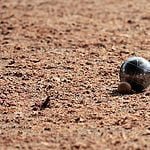Imagine your disc soaring through the air, smoothly curving to the right before landing exactly where you intended.
This precision in flight is often achieved through mastering the hyzer throw in disc golf. But what exactly is a hyzer, and how can understanding this technique elevate your game to new heights?
Let's explore the intricacies of hyzer throws and uncover the secrets behind this fundamental skill that can make all the difference on the course.
Key Takeaways
- Hyzer is a release angle technique for predictable left-curved flights.
- It offers accurate distance control and reliable left fade.
- Hyzer technique is essential for consistent and precise disc golf shots.
- Understanding and mastering hyzer form enhances overall disc golf performance.
Definition of Hyzer
The hyzer in disc golf is a release angle technique where the disc's far edge is positioned lower than the close edge. When executing a hyzer shot, the release angle is crucial as it determines the flight path of the disc. By angling the disc in this manner, players can achieve a controlled shot that reliably fades to the left (for right-handed throwers) at the end of its flight. This predictable flight path is favored by many professionals for its consistency and accuracy.
One of the key features of a hyzer throw is that the angle remains constant from the moment of release until the disc comes to rest. This consistency allows players to gauge the trajectory of the disc more accurately, making it easier to plan and execute their shots. Mastering the nuances of hyzer angles is essential for any serious disc golfer looking to improve their game and achieve greater precision on the course.
Origin of Hyzer
Originating in the realm of disc golf, the term 'hyzer' was first introduced by Dr. Stancil Johnson in 1975 and draws inspiration from the achievements of long-distance champion H.R. Fling Hyzer. Dr. Johnson's contribution to the lexicon of disc golf terminologies has been pivotal in shaping the sport's language and techniques. The origin of 'hyzer' can be traced back to the book 'Frisbee: A Practitioners Manual,' where the concept was further elaborated upon, solidifying its place in the Disc Golf Association (PDGA) guidelines.
- Dr. Stancil Johnson's role in introducing 'hyzer' to disc golf lexicon.
- Inspiration from H.R. Fling Hyzer's long-distance achievements.
- 'Frisbee: A Practitioners Manual' as a foundational text for 'hyzer.'
- Integration of 'hyzer' into PDGA standards.
- Distinctiveness of 'hyzer' terminology in disc golf compared to other disc sports.
Mechanics of Hyzer Throw
Exploring the fundamental mechanics behind executing a hyzer throw in disc golf reveals the intricate interplay of release angle and flight path shaping. When throwing a hyzer shot, the disc is released with the far edge lower than the close edge, creating a flight path that curves to the left for right-handed players (RHBH). This angle of the disc, known as the hyzer angle, is crucial in determining the trajectory of the throw. By adjusting the hyzer angle, players can manipulate the flight path, resulting in different shot shapes and landing spots.
The flight plate of the disc plays a significant role in maintaining the desired angle throughout the flight. Whether executing a backhand or forehand throw, understanding how the edge of the disc interacts with the air is key to achieving a controlled flight. Hyzer throws are favored for their reliable fade at the end of the flight, allowing players to predictably land close to the target with precision. Mastering the mechanics of the hyzer throw provides disc golfers with a versatile tool for navigating various course layouts and challenging wind conditions.
Benefits of Hyzer Technique
Embracing the hyzer technique in disc golf empowers players with a reliable and controllable flight path. This technique offers various benefits that can significantly enhance your performance on the course:
- Predictable Flight Path: By utilizing the hyzer technique, you can achieve a consistent and predictable flight path for your disc, making it easier to plan your shots and anticipate where your disc will land.
- Distance Control: Hyzer shots provide easier distance control, allowing you to adjust the power and angle of your throw to achieve the desired distance while maintaining accuracy.
- Reliable Fade: Professionals often rely on hyzer shots for their reliable fade, which helps the disc finish to the left (for right-handed throwers) at the end of its flight, aiding in precise placement near the target.
- Shot Accuracy: Mastering hyzer throws can significantly improve your shot accuracy, as the technique allows for more consistent releases and more controlled flights, leading to better overall performance.
- Performance: Consistently incorporating the hyzer technique into your game can lead to improved performance outcomes, including better scores and more successful shots due to the technique's reliability and predictability.
Hyzer Release Angle
Understanding the hyzer release angle is fundamental for achieving consistent and controlled flight paths in disc golf. When releasing a disc on a hyzer angle, the far edge is lower than the close edge. This orientation causes the disc to naturally veer to the left during its flight, known as a fade, for right-handed backhand throws. By adjusting the hyzer angle, players can manipulate the disc's stability and shape its flight path around obstacles or towards specific landing zones.
This technique is particularly useful in windy conditions, as the hyzer angle can help counteract the effects of crosswinds and maintain the desired trajectory.
Mastering the hyzer release angle allows players to adapt to varying wind conditions and terrains effectively. It provides a level of predictability and control over the disc's flight, making it an essential skill for disc golfers looking to improve their game. By understanding how the hyzer angle influences the flight path, players can strategically use this technique to enhance their overall performance on the course.
Mastering the Hyzer Shot
To excel in mastering the hyzer shot in disc golf, focus on consistently releasing the disc with the far edge lower than the close edge to achieve reliable fade and controlled flight paths. Understanding how to manipulate the release angles is crucial for honing this skill.
Here are some tips to help you improve your hyzer shot:
- Experiment with different release angles to see how they affect the flight path.
- Practice with various discs to understand how each one responds to a hyzer release.
- Consider the impact of wind on your hyzer shots and adjust your angle accordingly.
- Focus on distance control by varying the power behind your throws.
- Aim for a consistent landing spot by fine-tuning your release technique.
Types of Hyzer Throws
Experiment with different angles to discover the nuances of various hyzer throws in disc golf.
Spike hyzers are ideal for controlled landings, requiring a high release angle that drives the disc into the ground.
On the other hand, hyzer flips provide versatility by starting with a hyzer release and transitioning smoothly into an anhyzer angle mid-flight, offering diverse flight paths.
Hyzer shots are characterized by maintaining their original release angle throughout the throw, ensuring a consistent trajectory from start to finish.
Anhyzer throws, in contrast, introduce unique flight possibilities and ground interactions compared to traditional hyzer throws.
Understanding these distinctions allows players to strategically navigate the course with a variety of shot options.
Whether executing a backhand throw or experimenting with different release angles, mastering the intricacies of spike hyzers, hyzer flips, and other hyzer variations can elevate your disc golf game to new heights.
Hyzer Vs. Anhyzer Comparison
In disc golf, distinguishing between a hyzer angle and an anhyzer angle is fundamental for controlling the flight path of your disc. When comparing hyzer and anhyzer throws, understanding their differences can greatly impact your game. Here are some key points to consider:
- Hyzer angle involves releasing the disc with the far edge lower than the close edge, causing the disc to curve left for right-handed players (RHBH).
- Anhyzer angle, on the other hand, requires releasing the disc with the far edge higher than the close edge, resulting in shots that curve to the right.
- Hyzer flips combine a hyzer release with an understable disc, transitioning from a hyzer angle to an anhyzer angle during flight.
- Different shot paths can be achieved by adjusting the angle of release between hyzer and anhyzer, allowing for versatile and strategic gameplay.
- Mastering the nuances of hyzer and anhyzer angles is essential for shaping precise and controlled flight paths in various disc golf scenarios.
Perfecting Your Hyzer Form
Understanding the proper release angle for a hyzer shot is crucial in perfecting your hyzer form in disc golf. When throwing a hyzer shot, ensure that the far edge of the disc is lower than the close edge, creating the desired hyzer angle. Experiment with different discs to find the right stability that suits your hyzer shots best. Here is a table to illustrate the importance of disc selection in perfecting your hyzer form:
| Disc Type | Stability Level |
|---|---|
| Overstable | Strong Hyzer |
| Stable | Moderate Hyzer |
| Understable | Gentle Hyzer |
| Midrange | Versatile Option |
Practice throwing hyzers consistently to develop muscle memory, allowing you to replicate the desired release angle with accuracy. Field practice is essential to fine-tune your hyzer form and understand how different angles affect the flight of the disc. By incorporating these tips into your practice routine and seeking instructional resources, you can enhance your hyzer technique and improve your overall disc golf game.
Hyzer Tips and Tricks
When executing a hyzer shot in disc golf, focus on maintaining the correct release angle where the far edge of the disc is lower than the close edge to achieve the desired flight path. Here are some tips and tricks to help you perfect your hyzer game:
- Experiment with Extreme Hyzer Angles: Try releasing the disc at a steeper angle to master extreme hyzer shots, which can be useful for navigating around obstacles.
- Utilize Overstable Discs for Consistency: Overstable discs are great for hyzer shots as they naturally fade at the end of their flight, providing reliable control.
- Practice Spikes into the Ground: For approach shots that need to stop quickly, practice throwing spike hyzers that come down vertically, preventing skips.
- Master the Hyzer Flip: Explore hyzer flip shots by starting with a hyzer release and then transitioning to an anhyzer angle for unique flight paths.
- Engage with Other Disc Golfers: Learning from and playing with other disc golfers can offer valuable insights and help you refine your hyzer techniques.





